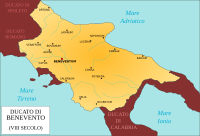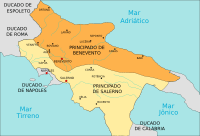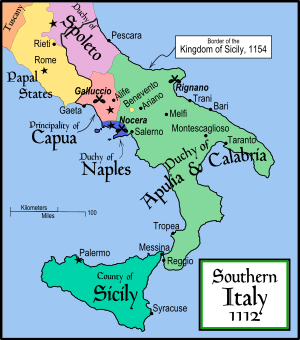Principality of Capua facts for kids
The Principality of Capua was an important state in southern Italy. It existed for about 200 years, from the 800s to the 1000s. For most of this time, it acted like an independent country. However, it was officially under the rule of the Holy Roman Empire in the west and the Byzantine Empire in the east.

Capua started as a small area called a "gastaldate" within the Principality of Benevento. Later, it became a "county" inside the Principality of Salerno. The rulers of Capua were Lombards, a Germanic people, until 1058. That's when Normans from northern Europe conquered it.
Contents
How Capua Began
Old Capua was a very old city, first built by the Etruscans. It was one of the most important cities in southern Italy during the Roman Empire. When the Lombards invaded Italy in the late 500s, Capua was attacked and destroyed.
Later, it became part of the Duchy of Benevento. A Lombard official called a gastald ruled it. We don't know much about this early period.
Capua first became its own state under Landulf I. In 839, the Duke of Benevento, Sicard, was killed. This led to a civil war that split the country. Sicard's brother, Siconulf, declared Salerno independent. Landulf, who was Sicard's ally, also declared Capua independent.
In 841, Capua was completely destroyed by soldiers hired by Sicard's killer. In 849, Landulf's son, Lando I, asked the Holy Roman Emperor to end the war. The emperor divided Benevento and Salerno into two separate states. Capua was made a "county" under Salerno. Since Old Capua was destroyed, Lando I built a new city in 856. This new city is the Capua that still exists today.
Lando didn't stay under Salerno's rule for long. Capua was attacked by Salerno and Naples in 859, but Capua won. Pando (who ruled from 861–862) declared Capua fully independent from Salerno in 862.
After Pando died, there was a fight over who would rule next. Pando's son, Pandenulf, was removed from power by his uncle, Landulf II. Landulf was also the bishop of Capua, so he controlled both politics and religion. When he died in 879, another civil war began.
Two people claimed the throne: Pandenulf (who had been removed before) and Lando III. Salerno sided with Lando III, and Benevento with Pandenulf. They both ruled different parts of the county. Pandenulf held the main city of Capua until Lando III captured it in 882.
Lando III and his brother, Landenulf I, spent their time defending Capua from Naples. Their other brother, Atenulf, had joined Naples against them. By 887, Atenulf became the Prince of Capua. He then decided to conquer Benevento.
Capua and Benevento Unite
In 899, Atenulf I defeated Radelchis II and took over Benevento. He was declared Prince of Benevento in 900. He joined the two states of Capua and Benevento and said they would always be together.
Atenulf also created a new system for ruling. Under this system, the prince's sons and brothers would rule alongside him. Atenulf hoped this would stop future fights over who would take the throne.
Atenulf made his son, Landulf III, a co-prince. They made alliances with nearby Greek states like Naples. After Atenulf died, Landulf continued his father's plans. He is famous for his part in the Battle of Garigliano, where the Saracens (Muslims from North Africa) were defeated. After this battle, he tried to weaken the Byzantine Empire's power in southern Italy.
His son, Landulf IV, allied against Salerno. Like his father, he attacked Byzantine lands but was defeated. Capua was then forced to become a vassal (officially under the rule) of the Byzantine Empire.
Under Landulf IV's sons, the union of Capua and Benevento began to break apart. Even though they were legally united, Pandulf ruled in Capua, and Landulf V ruled in Benevento.
However, all the Lombard states in Italy were eventually united under Pandulf, who was known as "Ironhead." The Emperor Otto I gave Pandulf more land in 967. When Landulf V died in 969, Pandulf took Benevento from his nephew. He also became Prince of Salerno in 978. Before Pandulf died, he divided his lands among his sons. Benevento and Capua went to his oldest son, Landulf VI.
Capua in the 1000s

Soon after, Benevento and Capua were separated by Emperor Otto I. Landulf VI kept Capua, while Benevento went back to his cousin. In the 990s, Capua faced a time of trouble. Landenulf II was killed by his brother Laidulf, who took the throne. When Emperor Otto III found out, he removed Laidulf. But Laidulf's replacement was then overthrown by the people of Capua.
The old ruling family was put back in power in 1000 under Landulf VII. He made his brother, Pandulf II of Benevento, a regent (someone who rules for a young or absent leader) for his son. Pandulf ruled alongside his nephew as Pandulf III of Capua. This was the last time Capua and Benevento were briefly united.
Capua became powerful again under Pandulf IV. He was removed from power twice between 1016 and his death in 1050. He was an ally of the Byzantines and fought against his neighbors. He often had problems with the church and with the coastal cities of Naples, Gaeta, and Amalfi. Because of his fierce nature, he was called the "Wolf of the Abruzzi". He wanted Capua to have a seaport. He removed the rulers of Naples and Gaeta and went to war against Guaimar IV, the Prince of Salerno. Emperor Henry II had him removed and imprisoned, but he eventually got his throne back.
The city became less important after Pandulf's time. It was eventually taken by the Norman allies of Guaimar IV.
Norman Rulers Take Over
The Norman count Richard of Aversa conquered Capua in 1058. He let the last Lombard ruler, Landulf VIII, stay in control of the city for four more years. But by 1062, Richard took full control. Richard became an ally of the Popes, but was later excommunicated (kicked out of the church). His son, Jordan I, captured some Papal land for Capua. He was also excommunicated. When Richard died, his family was very powerful in central Italy.
When Jordan I died in 1091, Capua's power quickly declined. From 1091 to 1098, the city of Capua was controlled by Lando IV. Lando was a Lombard who was put on the throne by the citizens. They were against the young Norman ruler, Richard II. Richard II only got his throne back with the help of other Normans from Sicily and Apulia. Capua then became dependent on Sicily.
The princes of Capua continued to try and influence who became Pope. When Jordan II died in 1127, the principality became a target for Roger II of Sicily. Roger had united Sicily, Apulia, and Calabria. For 20 years, from 1135 to 1155, Capua and Sicily were at war. Finally, Capua was annexed (taken over) into the Kingdom of Sicily.
Rulers of Capua
Below are the rulers of Capua from 840 to 1172.
- Legend
- The dates next to each ruler's name show when they ruled. If dates overlap, it means they ruled at the same time.
- Some rulers had a nickname or special description. This is listed after their name.
- In brackets, you'll see how each ruler was related to the person who ruled before them.
- Also in brackets, it might say if a ruler was a usurper (took the throne unfairly), was deposed (had their throne taken away), or was reinstated (got their throne back).
Lombard Rulers
Gastalds and Counts
The gastalds (or counts) of Capua were originally under the Dukes of Benevento. In the early 840s, Gastald Landulf I declared independence. This led to a civil war in Benevento. Later, Capua became a vassal of Salerno, but this didn't last. By the end of the 800s, Capua was mostly independent.
- 840–843: Landulf I, called "the Old"
- 843–861: Lando I (son of preceding)
- 861: Lando II, called Cyruttu (son of preceding, deposed)
- 861–862: Pando, called "the Rapacious" (uncle of preceding, usurper)
- 862–863: Pandenulf (son of preceding, deposed)
- 863–866: Landulf II, called "the Bishop"; also Bishop of Capua (uncle of preceding, usurper, deposed)
- 866–871: Lambert I, also Duke of Spoleto (unrelated, put on throne by Emperor Louis II, deposed)
- 871–879: Landulf II, called "the Bishop" (reinstated)
- 879–882: Pandenulf (reinstated)
- 882–885: Lando III (cousin of preceding, usurper)
- 885–887: Landenulf I (brother of preceding)
Princes of Capua
In 899, the states of Benevento and Capua were united by Atenulf I. Until 982, all the rulers listed below were Prince of both Capua and Benevento. Atenulf also created a system where fathers would rule with their sons or brothers.
- 887–910: Atenulf I, called "the Great" (brother of preceding)
- 901–910: Landulf III, co-ruler (son of Atenulf I)
- 910–943: Landulf III, called "Antipater" (had co-ruled from 901)
- 911–940: Atenulf II, co-ruler (brother of Landulf III)
- 933–943: Atenulf III, called "Carinola"; co-ruler (son of Landulf III)
- 940–943: Landulf IV, co-ruler (son of Landulf III)
- 943–961: Landulf IV, called "the Red" (had co-ruled from 940)
- 943–961: Pandulf I, co-ruler (son of Landulf IV)
- 959–961: Landulf V, co-ruler (son of Landulf IV)
- 961–968: Landulf V, co-ruling with his brother, below (had co-ruled from 959)
- 961–981: Pandulf I, called "Ironhead", co-ruling with his brother, above (had co-ruled from 943). Also Duke of Spoleto (from 967) and Prince of Salerno (from 978).
- 968–981: Landulf VI, co-ruler (son of Pandulf I)
In 982, the principalities were finally separated by Pandulf Ironhead and Emperor Otto I.
- 981–982: Landulf VI
- 982–993: Landenulf II (brother of preceding)
- 993–999: Laidulf (brother of preceding, deposed)
- 999: Adhemar (unrelated, put on throne by Emperor Otto III, deposed)
- 999–1007: Landulf VII (cousin of preceding)
- 1007–1022: Pandulf II, called "the Black" or "the Young" (son of preceding)
- 1009–1014: Pandulf III, co-ruler, also Prince of Benevento (brother of Landulf VII)
- 1016–1022: Pandulf IV, co-ruler (cousin of Pandulf II, deposed)
- 1022–1026: Pandulf V, also count of Teano (unrelated, put on throne by Emperor Henry II, deposed)
- 1023–1026: John, co-ruler (son of Pandulf V, deposed)
- 1026–1038: Pandulf IV (reinstated, deposed)
- 1038–1047: Guaimar, also Prince of Salerno (unrelated, usurper, deposed)
- 1047–1050: Pandulf IV (reinstated)
- 1050–1057: Pandulf VI (son of preceding)
- 1057–1058: Landulf VIII (brother of preceding)
Norman Princes
These princes were from the Drengot family.
- 1058–1078: Richard I
- 1078–1091: Jordan I (son of preceding)
- 1091–1106: Richard II (son of preceding)
- 1092–1098: Lando IV, (unrelated, held Capua in opposition to Richard II)
- 1106–1120: Robert I (brother of preceding)
- 1120: Richard III (son of preceding)
- 1120–1127: Jordan II (uncle of preceding)
- 1127–1156: Robert II (son of preceding)
- Ferdinand Chalandon. Histoire de la domination normande en Italie et en Sicile. Paris, 1907.
- Dizionario Biografico degli Italiani. Rome, 1960–present.
- Charles Oman. The Dark Ages: 476–918. Rivingtons: London, 1914.
- H. M. Gwatkin, J. P. Whitney (ed.) et al. The Cambridge Medieval History: Volume III. Cambridge University Press, 1926.
- John Julius Norwich. The Normans in the South 1016–1130. Longmans: London, 1967.
See also
 In Spanish: Principado de Capua para niños
In Spanish: Principado de Capua para niños




